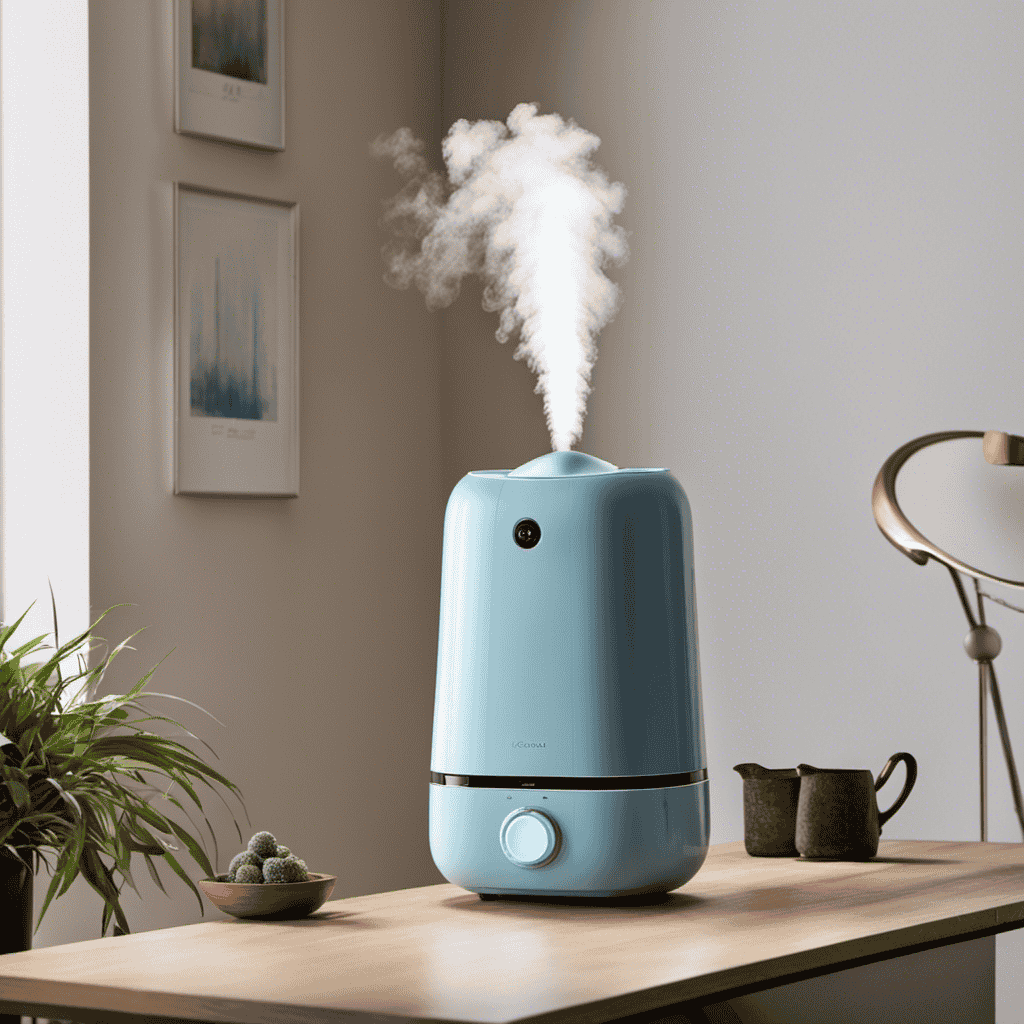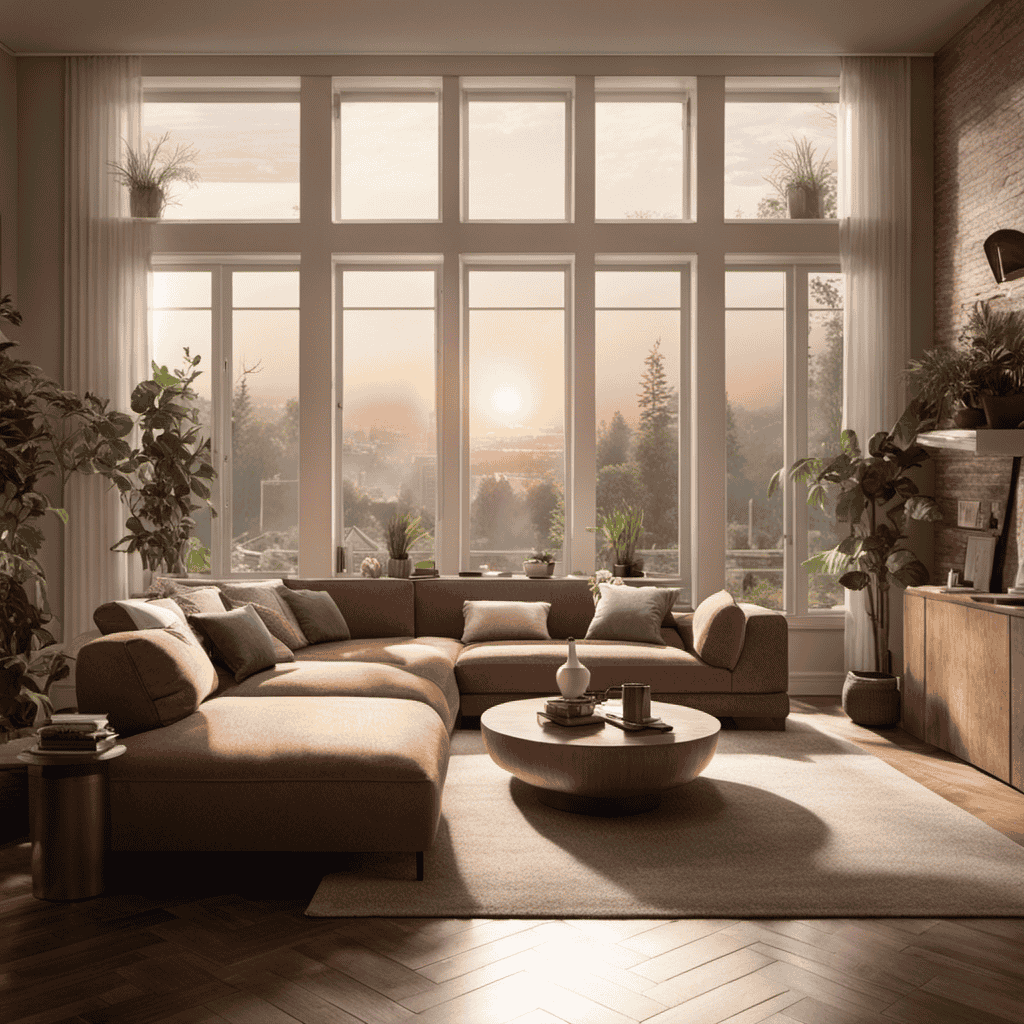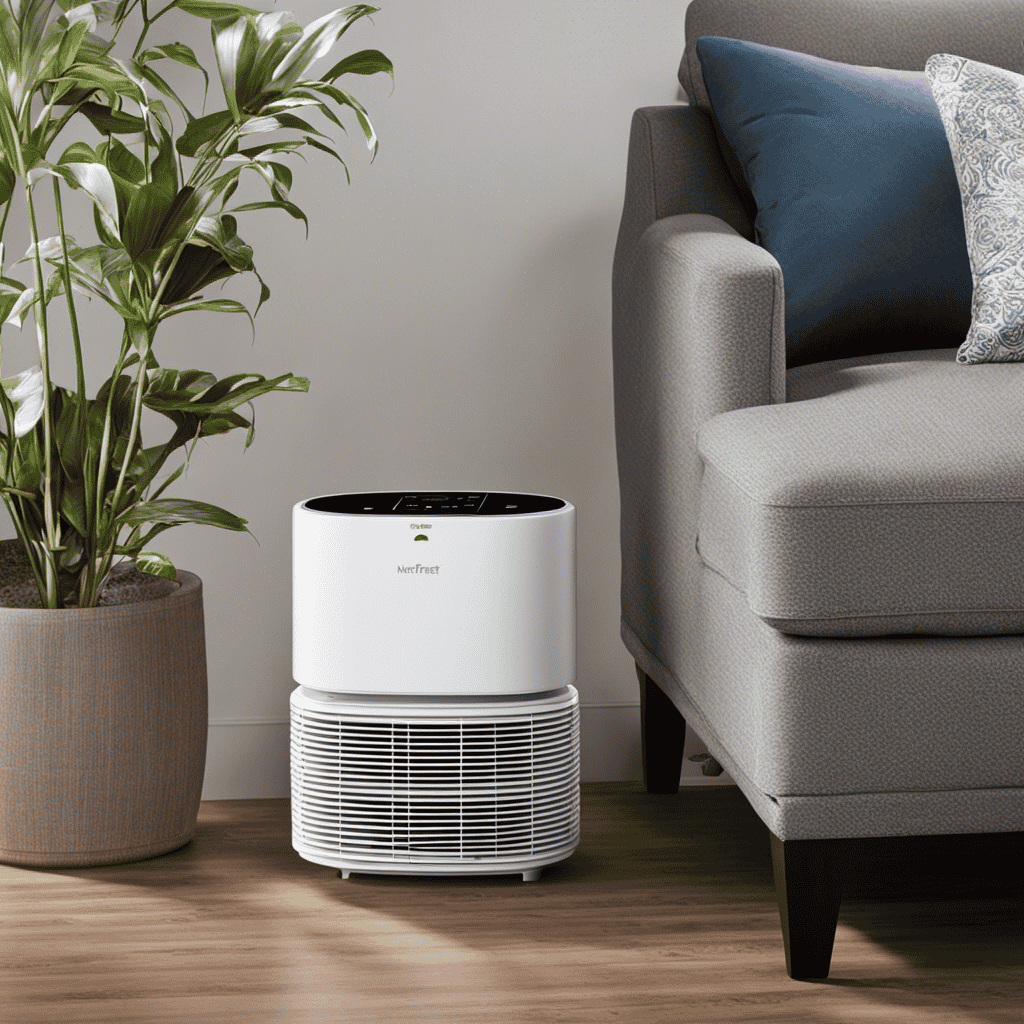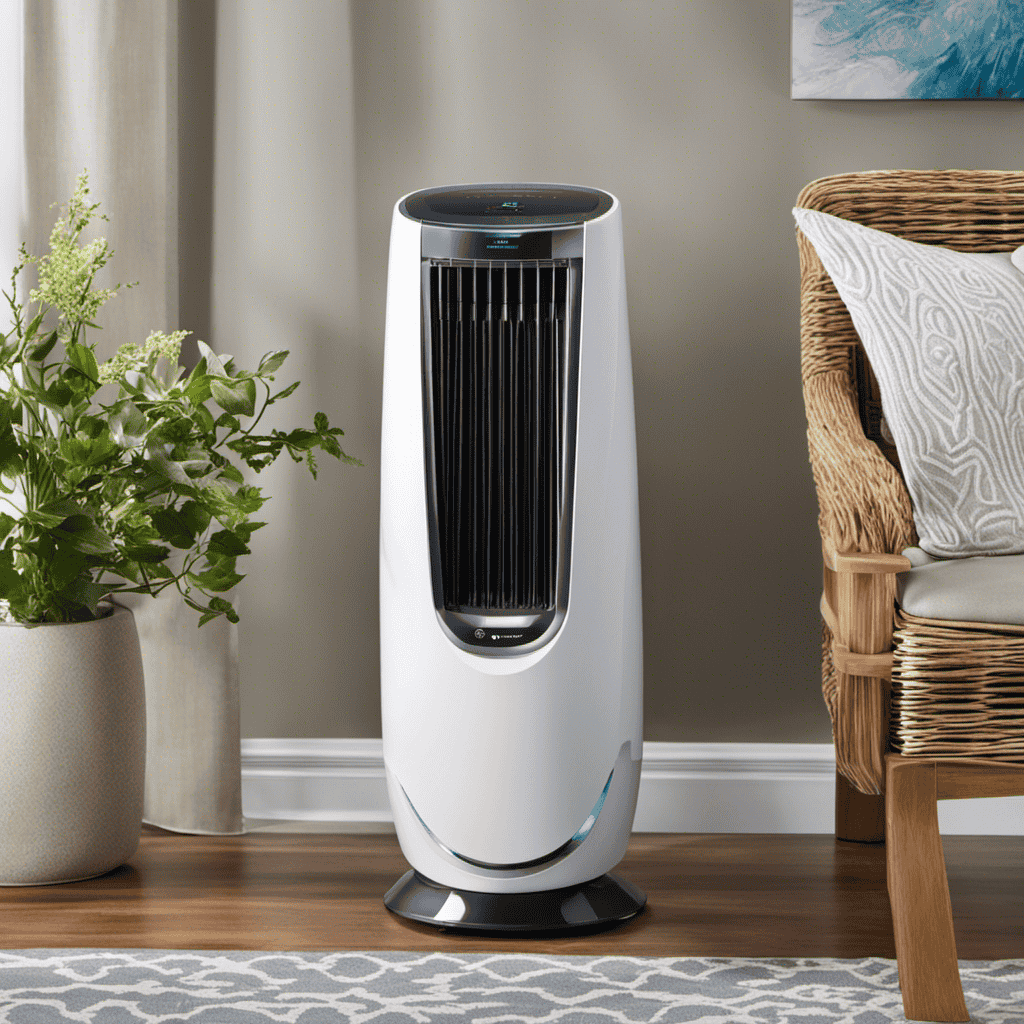The old adage states that ‘knowledge is power.’
And when it comes to creating a healthier indoor environment, understanding the difference between a humidifier and an air purifier can make all the difference.
In this article, I’ll provide a comprehensive comparison of these two essential devices. By exploring their functionality, purpose, humidity control, air quality improvement, targeted issues, noise level, compatibility with other devices, warranty, and customer support, we’ll uncover the nuances that can help you make an informed decision based on your personal preference.
So, let’s dive in and empower ourselves with knowledge.
Key Takeaways
- Humidifiers add moisture to the air, improving humidity levels and preventing dry skin, irritated eyes, and respiratory discomfort.
- Air purifiers remove pollutants such as dust, pollen, pet dander, and smoke, ensuring cleaner and healthier air to breathe and reducing respiratory issues and allergies.
- Balancing moisture levels with clean air is crucial for creating a healthy and comfortable living space.
- Personal preference and specific needs determine the choice between a humidifier and an air purifier, but both play vital roles in improving indoor environments.
Functionality
If you’re looking for a device that can clean the air and remove impurities, an air purifier is what you need.
While both humidifiers and air purifiers are designed to improve air quality, they serve different purposes.
An air purifier focuses on removing pollutants from the air, such as dust, pollen, pet dander, and smoke. It uses filters, such as HEPA filters, to trap these particles and purify the air.
On the other hand, a humidifier is specifically designed to control humidity levels in a room. It adds moisture to dry air, helping to alleviate symptoms of dry skin, dry throat, and sinus congestion.
Purpose
When it comes to indoor environments, one often faces the dilemma of choosing between humidity or air quality. Both factors play a significant role in maintaining a healthy and comfortable living space.
While humidity helps to keep our skin moisturized and prevent respiratory issues, clean air is essential for reducing allergens and pollutants that can cause respiratory problems.
In this discussion, I will delve into the importance of finding a balance between moisture and clean air, and how it can contribute to a healthier and more comfortable living environment.
Humidity Vs. Air Quality
To improve your air quality, a humidifier can add moisture to the air, while an air purifier can remove pollutants.
When it comes to humidity control, a humidifier is the go-to option. It helps in maintaining the optimal moisture levels in the air, preventing issues like dry skin, irritated eyes, and respiratory problems.
On the other hand, air purifiers are designed to remove contaminants such as dust, pet dander, pollen, and even harmful gases from the air, ensuring cleaner and healthier air to breathe.
If you are unsure about the quality of your indoor air, air quality testing can help identify any potential pollutants or allergens.
Both humidifiers and air purifiers play vital roles in creating a healthier indoor environment, but the choice ultimately depends on whether you prioritize moisture or clean air.
Moisture or Clean Air?
Maintaining the optimal moisture levels in the air is important for preventing issues like dry skin and respiratory problems, while ensuring cleaner and healthier air to breathe.
Humidity control plays a crucial role in creating a comfortable and healthy indoor environment. When the air is too dry, it can lead to dry skin, irritated eyes, and respiratory discomfort. On the other hand, excessive humidity can promote the growth of mold, bacteria, and dust mites, which can worsen allergies and cause respiratory issues.
To address these concerns, both humidifiers and air purifiers can be used. A humidifier adds moisture to the air, while an air purifier removes particles and contaminants, improving air quality.
It is important to find the right balance between humidity control and air purification to create a healthy and comfortable living space.
Humidity Control
If you’re looking to control the humidity levels in your home, a humidifier can help add moisture to the air. Maintaining proper humidity levels is essential for your health and overall well-being. Here are three key points to consider when it comes to humidity control:
-
Health effects: Low humidity can lead to dry skin, irritated eyes, and respiratory issues. On the other hand, high humidity can promote the growth of mold and bacteria, which can worsen allergies and asthma symptoms.
-
Ideal humidity levels: The ideal humidity level for most homes is between 30% and 50%. This range ensures comfort and prevents the negative health effects associated with both low and high humidity.
-
Benefits of a humidifier: Using a humidifier can help alleviate dry skin, soothe respiratory symptoms, and improve sleep quality. It can also prevent wood furniture and flooring from cracking due to excessively dry air.
Air Quality Improvement
When it comes to improving air quality, two devices that often come to mind are air purifiers and humidifiers.
Air purifiers are designed to remove pollutants and allergens from the air, such as dust, pet dander, and pollen. They can be particularly beneficial for individuals with respiratory conditions or allergies.
On the other hand, humidifiers are used to control the moisture levels in the air, which can help alleviate dry skin, nasal congestion, and irritated eyes.
Both of these devices have their own unique benefits and can work together to create a healthier and more comfortable indoor environment.
Benefits of Air Purifiers
Air purifiers can effectively remove pollutants and allergens from the air, improving the overall air quality in your home. They are an essential tool for maintaining a healthy living environment.
Here are three key benefits of using an air purifier:
-
Allergen removal: Air purifiers can capture and eliminate common allergens such as pollen, dust mites, pet dander, and mold spores. This is especially beneficial for individuals with allergies or asthma, as it can help alleviate symptoms and improve breathing.
-
Odor reduction: Air purifiers can also help eliminate unpleasant odors caused by cooking, pets, or smoke. By filtering out the particles responsible for these odors, air purifiers can leave your home smelling fresh and clean.
-
Overall health improvement: With cleaner air, the risk of respiratory illnesses and infections decreases. Air purifiers can also reduce exposure to harmful volatile organic compounds (VOCs) emitted from household products, improving the overall health and well-being of you and your family.
Investing in the right type of air purifier for your specific needs can greatly enhance the effectiveness of the device. There are several types available, including HEPA filters, activated carbon filters, and UV germicidal lamps. Each type targets different pollutants and allergens, so it’s important to choose one that suits your requirements.
Humidifiers for Moisture Control
Using a humidifier can help control the moisture levels in your home, preventing dryness and promoting overall comfort. Maintaining proper moisture levels is essential for both our health and the health of our homes. When the air in our homes becomes too dry, it can lead to a range of health effects, including dry skin, irritated nasal passages, and respiratory issues. By adding moisture to the air, a humidifier helps to alleviate these symptoms and create a more comfortable living environment. Additionally, it can help to prevent damage to wooden furniture, reduce static electricity, and even prolong the life of houseplants. To further understand the importance of moisture control, let’s take a look at the following table:
| Moisture Level | Health Effects |
|---|---|
| Too Low | Dry skin, irritated nasal passages, respiratory issues |
| Too High | Increased mold growth, dust mite infestation, respiratory issues |
| Optimal | Healthy skin, improved respiratory function, reduced allergy symptoms |
Targeted Issues
There’s a noticeable difference between a humidifier and an air purifier when it comes to addressing targeted issues. Here are three key points to consider:
-
Humidity Effects: A humidifier adds moisture to the air, helping to alleviate dryness in the environment. This can be beneficial for those suffering from dry skin, allergies, or respiratory issues caused by low humidity levels. On the other hand, an air purifier focuses on removing pollutants and allergens from the air, improving indoor air quality.
-
Health Risks: Low humidity levels can lead to various health problems, such as dry skin, irritated eyes, and respiratory issues. A humidifier can help alleviate these symptoms by increasing the moisture content in the air. However, excessive humidity can create a breeding ground for mold, dust mites, and bacteria, which can contribute to allergies and respiratory problems. An air purifier can help eliminate these harmful particles, ensuring cleaner and healthier air.
-
Targeted Solutions: Depending on your specific needs, you can choose between a humidifier or an air purifier. If you are primarily concerned with dryness and its associated health effects, a humidifier would be the ideal choice. On the other hand, if you want to improve indoor air quality and reduce the presence of allergens and pollutants, an air purifier would be more suitable.
Health Benefits
In terms of health benefits, both humidifiers and air purifiers can be beneficial, but they target different aspects of indoor air quality. Humidifiers add moisture to the air, which can help alleviate dry skin, dry throat, and sinus congestion. On the other hand, air purifiers are designed to remove pollutants and contaminants from the air, such as dust, pollen, pet dander, and mold spores. They can improve indoor air quality and reduce the risk of respiratory issues and allergies.
When it comes to choosing between a humidifier and an air purifier, it ultimately depends on personal preference and specific needs. Some individuals may prioritize adding moisture to the air, while others may be more concerned about eliminating airborne particles. It is also possible to use both devices in combination for maximum air quality improvement.
| Health Benefits | Humidifier | Air Purifier |
|---|---|---|
| Alleviates dryness | Adds moisture to the air, reducing dry skin, dry throat, and sinus congestion. | N/A |
| Removes pollutants | N/A | Removes airborne particles such as dust, pollen, pet dander, and mold spores, improving indoor air quality and reducing the risk of respiratory issues. |
| Reduces allergies | Can help alleviate allergy symptoms related to dryness, but does not directly target the removal of allergens from the air. | Removes allergens from the air, reducing the risk of allergic reactions and providing relief to individuals with allergies. |
Mechanism of Action
When it comes to maintaining indoor air quality, two key factors to consider are humidity control and airborne pollutant removal.
Humidity control methods, such as the use of humidifiers, can help regulate the moisture levels in the air, which is crucial for preventing the growth of mold and bacteria.
On the other hand, air purifiers are designed to remove airborne pollutants, such as dust, pollen, and pet dander, improving the overall air quality and reducing the risk of respiratory issues.
Both humidity control and airborne pollutant removal play important roles in creating a healthier indoor environment.
Humidity Control Methods
To control the humidity in your home, you can use either a humidifier or an air purifier. Maintaining proper humidity levels is crucial for respiratory health. Here are three methods to effectively control humidity:
-
Humidifier: A humidifier adds moisture to the air, increasing humidity levels. It is especially beneficial during dry winter months or in arid climates. This helps alleviate dryness in the throat, nose, and skin, reducing the risk of respiratory infections.
-
Dehumidifier: On the other hand, a dehumidifier removes excess moisture from the air, lowering humidity levels. This is useful in humid environments, preventing the growth of mold, mildew, and dust mites. By reducing excessive moisture, it can improve respiratory conditions for individuals with allergies or asthma.
-
Air purifier with humidifying function: Some air purifiers come with a built-in humidifying function. These devices filter out pollutants in the air while simultaneously adding moisture. They are a convenient option for maintaining optimal humidity levels and improving respiratory health.
Airborne Pollutant Removal
Now that we have discussed various methods for humidity regulation, let’s shift our focus to the topic of airborne pollutant removal.
Air purifiers are devices designed to remove contaminants from the air, improving indoor air quality. There are different types of air purifiers available in the market, each with its own mechanism for pollutant removal.
Some common types include mechanical filters, electrostatic precipitators, and activated carbon filters. Mechanical filters work by trapping particles in a filter media, while electrostatic precipitators use an electric charge to attract and collect particles. Activated carbon filters are effective in removing odors and chemicals from the air.
It is important to choose the right type of air purifier based on your specific needs and the pollutants you want to eliminate from your indoor environment.
Maintenance Requirements
If you don’t clean the humidifier regularly, it can become a breeding ground for bacteria and mold. To ensure proper maintenance and prevent these issues, here are three important steps to follow:
-
Clean the humidifier regularly: To keep the humidity level in your home at a healthy range, it’s essential to clean the humidifier at least once a week. This involves emptying and rinsing the water tank, wiping down all surfaces, and disinfecting any removable parts.
-
Replace the filter as needed: Filters in humidifiers help trap impurities and prevent them from being dispersed into the air. Over time, these filters can become clogged and less effective. It’s important to check the manufacturer’s guidelines to determine when to replace the filter and ensure optimal performance.
-
Monitor humidity levels: Regularly check the humidity level in your home using a hygrometer. Keeping the humidity level between 30% and 50% can help prevent the growth of bacteria and mold while maintaining a comfortable indoor environment.
Energy Consumption
Monitoring the energy usage of your humidifier can help you determine if it is operating efficiently. This is important not only for saving energy and reducing your electricity bill, but also for minimizing the environmental impact of your device. Humidifiers can consume a significant amount of energy, especially if they are not designed to be energy-efficient. By keeping an eye on the energy consumption of your humidifier, you can make informed decisions about its usage and potentially reduce unnecessary energy waste.
To illustrate the energy efficiency of different humidifiers, consider the following table:
| Humidifier Model | Power Consumption (Watts) | Energy Efficiency Rating |
|---|---|---|
| Model A | 150 | A+ |
| Model B | 200 | A |
| Model C | 250 | B |
| Model D | 300 | C |
| Model E | 350 | D |
Cost Considerations
To make sure you’re getting the best value for your money, take into account the long-term costs of maintenance and replacement filters when choosing a humidifier. Here are three important factors to consider for cost effectiveness and long term savings:
-
Type of humidifier: Different types of humidifiers have varying maintenance requirements and filter replacement costs. For example, evaporative humidifiers require regular cleaning of the wick filter, while ultrasonic humidifiers may need demineralization cartridges. Understanding the maintenance needs of each type can help you estimate the long-term expenses.
-
Filter lifespan: Consider the lifespan of the filters used in the humidifier. Some filters need to be replaced every few months, while others can last up to a year. Longer filter lifespan means fewer replacements and lower costs over time.
-
Filter availability and cost: Check the availability and cost of replacement filters for the humidifier you are considering. Make sure the filters are easily accessible and reasonably priced, as this can significantly impact the long-term maintenance costs.
Size and Portability
When considering size and portability, think about how easily you can move the humidifier from one room to another. Humidifiers come in various sizes and offer different portability options. Some models are compact and lightweight, making them easy to carry and transport. Others may be larger and have wheels or handles for convenient movement. The size variations allow you to choose a humidifier that fits your space and lifestyle.
If you plan to use the humidifier in multiple rooms, a smaller and more portable option would be ideal. On the other hand, if you intend to keep it in one room, a larger size may be suitable. Considering the portability and size of the humidifier is essential to ensure it meets your needs and preferences.
Now let’s explore another important aspect of humidifiers: their noise level.
Noise Level
When it comes to choosing a humidifier or an air purifier, one important factor to consider is the noise level. Some models are designed to operate silently, while others may produce disruptive noise. This can have a significant impact on sleep quality, as excessive noise can disrupt sleep patterns and prevent deep, restorative rest.
Therefore, it is crucial to consider the noise level of the device before making a decision, especially if you plan to use it in a bedroom or other quiet space.
Silent or Disruptive
If you’re looking for a quiet option, an air purifier might be the better choice. When it comes to humidity vs. air quality, it’s important to consider whether you prioritize moisture or clean air.
Here are three reasons why an air purifier can provide a silent and effective solution for improving air quality:
-
Noiseless Operation: Unlike humidifiers, which often produce a noticeable buzzing or gurgling sound, modern air purifiers are designed to operate quietly. This ensures a peaceful environment without any disturbance.
-
Multiple Filtration Technologies: Air purifiers employ various filtration technologies, such as HEPA filters, activated carbon filters, and UV sterilization, to remove allergens, pollutants, and odors from the air. This comprehensive purification process helps maintain clean and fresh air in your home.
-
Versatile Usage: Air purifiers can be used in any room, regardless of the humidity level. They do not add moisture to the air, making them suitable for both dry and humid environments.
Transition: While noise can disrupt sleep, it’s not the only factor to consider. Let’s now explore the impact of noise on sleep and how humidifiers and air purifiers differ in this aspect.
Noise Impact on Sleep
Transitioning to the impact of noise on sleep, it’s important to consider how different factors can affect the quality of rest. Noise reduction plays a crucial role in improving sleep quality. Excessive noise can disrupt sleep and lead to various health issues such as fatigue, irritability, and decreased cognitive function. To emphasize the importance of noise reduction, let’s take a look at the table below:
| Noise Level (dB) | Effect on Sleep |
|---|---|
| 30-40 | Peaceful |
| 50-60 | Mildly disruptive |
| 70-80 | Highly disruptive |
As seen in the table, noise levels above 50-60 dB can significantly disrupt sleep. Therefore, investing in noise-reducing devices, such as silent humidifiers and air purifiers, can greatly improve sleep quality. These devices are designed to operate quietly, ensuring a peaceful and undisturbed sleep environment.
Compatibility With Other Devices
To ensure your devices work well together, make sure the humidifier and air purifier are compatible with each other and any other devices you plan to use. Here are three important things to consider when checking compatibility:
-
Smart Home Technology: If you have a smart home setup, you’ll want to ensure that your humidifier and air purifier can be integrated into your system. Check if they are compatible with popular smart home platforms like Amazon Alexa or Google Home. This way, you can control them remotely or even set up automation routines.
-
App Connectivity: Many modern humidifiers and air purifiers come with their own mobile apps. Check if these apps are compatible with your smartphone’s operating system. This will allow you to easily monitor and control your devices from anywhere, providing convenience and ease of use.
-
Impact on Indoor Plants: If you have indoor plants, consider the impact of the devices on them. Some air purifiers emit ozone, which can be harmful to certain plants. Ensure that the air purifier you choose does not emit ozone or has a low ozone emission level to protect your beloved plants.
Warranty and Customer Support
When considering the warranty and customer support, make sure to check the terms and conditions to see what is covered and how to contact customer support if you have any issues. It is crucial to understand the warranty coverage provided by the manufacturer for your humidifier or air purifier.
Read the fine print to know if the warranty covers defects in materials or workmanship, and for how long. Some warranties may also cover certain parts or repairs.
Additionally, take the time to read customer reviews about the warranty and customer support experience. This will give you insights into how responsive and helpful the company is when it comes to addressing any concerns or providing assistance.
Personal Preference
If you’re unsure which one to choose, consider your personal preference for factors like design, noise level, and ease of use. When it comes to personal preference, everyone is unique and what works for one person may not work for another.
Here are three items to consider when making a decision:
-
Design: Some people prefer sleek and modern designs, while others may prefer a more traditional look. Consider which design fits your personal style and matches the aesthetics of your home.
-
Noise level: Depending on your tolerance for noise, you may want to choose a device that operates quietly. Some humidifiers and air purifiers can be noisy, especially at higher settings. Look for models that offer a noise level that suits your preference.
-
Ease of use: Consider how user-friendly the device is. Some people prefer devices with simple controls and easy maintenance, while others may enjoy more advanced features. Think about your comfort level with technology and choose a device that aligns with your user experience preferences.
Can an Air Purifier Also Act as a Humidifier?
Yes, there is a significant difference between an air purifier and a humidifier. While an air purifier cleans the air by removing pollutants and allergens, a humidifier adds moisture to the air. However, some air purifiers come with a built-in humidifier function, combining the benefits of both devices.
Frequently Asked Questions
Can a Humidifier Also Work as an Air Purifier?
Yes, a humidifier can help improve indoor air quality by adding moisture to dry air. However, it does not have the same air purifying capabilities as an air purifier, which is specifically designed to remove pollutants and allergens from the air.
What Are the Specific Health Benefits of Using an Air Purifier?
Using an air purifier has specific health benefits, such as reducing indoor air pollution and allergens. It’s important to note that a humidifier and air purifier are different devices, serving distinct purposes.
How Often Do I Need to Clean and Maintain a Humidifier?
I clean and maintain my humidifier regularly to ensure proper functioning. Cleaning frequency depends on the type of humidifier and water quality. Proper maintenance includes regular filter replacement and disinfection to prevent bacterial growth.
Do Air Purifiers Consume a Lot of Energy?
Air purifiers vary in energy consumption depending on the model and usage. It’s important to consider the environmental impact and choose an energy-efficient option. Regular maintenance and filter replacements also impact energy consumption.
Are There Any Compatibility Issues When Using a Humidifier or Air Purifier With Other Devices in My Home?
When using a humidifier or air purifier, it’s important to consider compatibility issues with other devices in your home. These devices can have a significant impact on air quality, so proper integration is crucial.
Conclusion
In conclusion, after examining the functionality, purpose, humidity control, and air quality improvement, it is clear that both humidifiers and air purifiers have their own unique benefits.
While humidifiers focus on maintaining optimal humidity levels, air purifiers work towards improving air quality.
Ultimately, the choice between the two depends on individual needs and preferences. So, whether you prioritize moisture or clean air, there’s a solution out there to meet your specific requirements.










